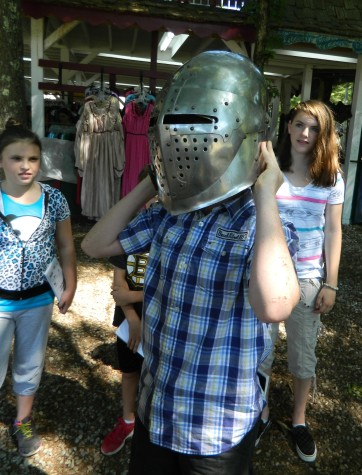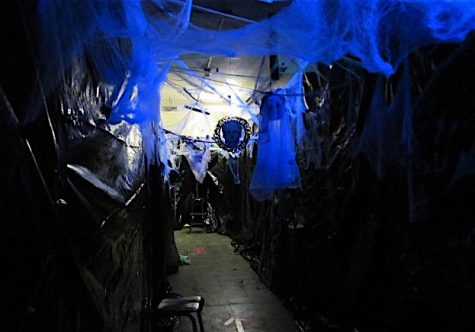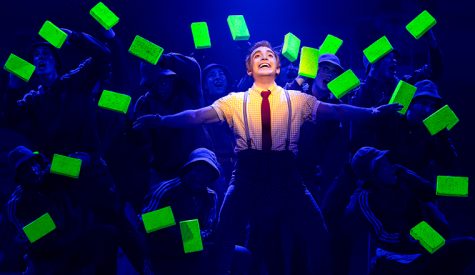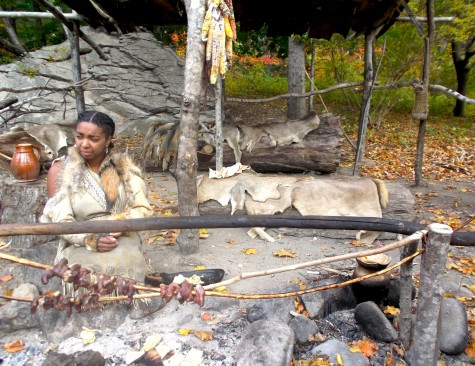Jousting is as easy as falling off a horse
Go under the armor and discover what it’s like to be a knight participating in the joust at King Richard’s Faire
If falling off horses and getting in real live sword fights is your dream job, then being a jouster is the right fit for you.
Joe Darrigo is the director of jousting at King Richard’s Faire in Carver, Mass. He manages people, paperwork, public relations, horse maintenance, and even the choreography of the shows.
Joe didn’t start all the way at the top though. When he was first hired in 1989, he worked in the kitchens. Over the years he worked his way up though the booths, games, and scenarios, until, in 1994, he became a squire. A squire is the person who assists the jousters during the performances and also repairs all of the jousters’ gear. After a while, Joe became a jouster and now is the director of the joust.

King Richard’s Faire is a medieval fair, and the jousters are playing the role of knights in medieval times.
Jousters ride on giant horses at each other at 25 mile per hour. They carry long sticks called lances and try to knock their opponent off his horse. The jousters wear 70 pounds of equipment and armor that can cost $3,500 and up.
Joe works for Hanlon-Lees Action Theater, a company of stuntmen based in Oklahoma. The stuntmen do all kinds of things, from live action to films. Joe has been a stunt double on the TV show “Early Edition” and in the film “Black Knight.”
“Jousters are stuntmen, not daredevils,” Joe said. “Daredevils do anything once, where as stuntmen do anything over and over again.”
He says is inspiration to become a jouster came when when he was a little kid. He would watch old movies, when all of the actors did their own stunts, so he felt like he had some kind of a calling.
Jousting isn’t easy. It is actually very dangerous. Joe has had several somewhat serious injuries. He has broken his collarbone and some fingers and he has dislocated his shoulder. He says he has had so many concussions that he lost count.
“On show day, I am always nervous because you can get injured easily,’’ he said. “That is why we practice.”
The week leading up to Opening Day is called Hell Week. For the jousters, it is truly insane. The work day starts at 8 a.m. when they feed and tend to the horses. During the day, they practice their moves on and off the horses.
In preparation for the fair, Joe writes all the scripts and trains the new people coming on board.
All of the jousters need to come together and rehearse the act to make sure that everyone can do it without even giving it a second thought.
They also have to keep the horses healthy and fit. Any equipment that breaks down, they are responsible for the repairs. They have to make sure their armor is in order. Joe has made a lot of his own armor.
They have to figure out everything, from the scripts to the fights to the choreography. They also have to work with the actors at King Richard’s Faire. Joe’s character is Sir Amadeo, the Count of Mantua.
Joe said during Hell Week there is literally no time to spare.
To become a jouster, you need to have a certain skill set. You have to be able to control all the props and the horses. The jousters have to be able to carry 60-70 pounds of authentic armor to make sure they don’t get hurt. They have to be able to remember a fight and perform it..
“It is mentally tiring and physically demanding,” Joe said.
At any Renaissance fair, the jousting arena is the biggest thing there is. He explained that there is a fair in Texas with a jousting arena that holds 11,000 people. The jousting arena at King Richards Faire is not that big, but holds 3,500 people. There are three different shows each day.
“[Performing] is an adventure,’’ he said. “It’s an adrenaline rush.”
(To see the joust, go to King Richard’s Faire. It is open weekends and holidays from Aug. 30 though Oct. 19. For information, go to http://kingrichardsfaire.net/.)
–Sept. 1, 2014–








